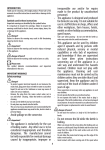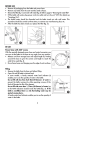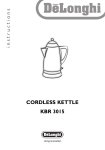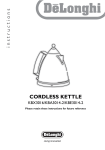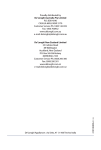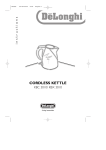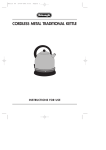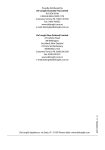Download DeLonghi Icona KBO 2001.W
Transcript
IMPORTANT SAFEGUARDS GB Please read these instructions before operating and retain for future reference. • Ensure that your mains supply voltage is the same as that marked on the underside of your kettle. • The appliance is designed and produced for domestic use only. It is not suitable for use in: - staff kitchens in shops, offices and other workplaces, - farm houses, - hotels, motels or other holiday accommodation, - guest houses. • To protect against electrical hazards do not immerse the mains lead, plug power base or kettle in water or any other liquid. Do not use in the bathroom or near any source of water. Do not use outdoors. • Do not touch hot surfaces i.e. body or lid. Use handles or knobs. • Do not remove the lid while the kettle is boiling. • Take care when pouring - do not over-tilt the kettle as water may enter into the switch mechanism. • Water can remain hot for a long time after boiling, and can present a scald hazard. Keep the kettle and the mains lead away from the edge of the work surface and out of the reach of children. • The appliance is not intended for use by persons (including children) with reduced physical, sensory or mental capabilities, or lack of experience and knowledge, unless they have been given supervision or instruction concerning use of the appliance by a person responsible for their safety. Children should be supervised to ensure that they do not play with the appliance. • Young children should be supervised to ensure that they do not play with the appliance. • Do not allow the mains lead to hang over the edge of the table or work surface, or anywhere it may be accidentally caught or tripped over. • Close supervision is necessary when any appliance is used near children. • Remove the plug from the mains socket when not in use and before cleaning. Allow the kettle to cool before cleaning. • Remove the kettle from its power base before filling. • Never move the kettle whilst it is in use. • Do not use the kettle if you have wet hands. • Keep the kettle, the power base, and the mains lead away from hotplates, hobs or burners. • Do not use the kettle for any purpose other than heating water. Do not place any utensils into the kettle. The use of accessory attachments not recommended by the appliance manufacturer may result in fire, electric shock or personal injury. • Never use the kettle without it’s lid. • Caution: do not operate on an inclined surface • Do not move while switched on. • Position the kettle properly on the power base before switching on. • Use the kettle only with the power base supplied (and vice versa). • Do not operate this kettle if the mains lead or plug is damaged, if the kettle malfunctions, or has been damaged in any manner. It must be returned to a service agent for repair or replacement in order to avoid hazard. • If the supply cord is damaged, it must be replaced by the manufacturer, its service agent in order to avoid a hazard. • If the kettle is overfilled, boiling water may overflow. • Materials and accessories coming into contact with food conform to EC regulation 1935/2004. Failure to observe these cautions may result in damage to the kettle. 4 ELECTRICAL REQUIREMENTS Before using this appliance ensure that the voltage indicated on the product corresponds with the main voltage in your home, if you are in any doubt about your supply contact your local electricity company. The flexible mains lead is supplied connected to a B.S. 1363 fused plug having a fuse of 13 amp capacity.Should this plug not fit the socket outlets in your home, it should be cut off and replaced with a suitable plug, following the procedure outlined below. Note: Such a plug cannot be used for any other appliance and should therefore be properly disposed of, (having removed the fuse) and not left where children might find it and plug it into a supply socket - with the obvious consequent danger. If the plug is a moulded-on type the fuse cover must be refitted. If the fuse cover is lost, the plug must not be used until a replacement cover is obtained. The colour of the correct replacement fuse cover is that of the coloured insert in the base of the fuse recess or elsewhere on the plug. Always state this colour when ordering a replacement fuse cover. N.B. We recommend the use of good quality plugs and wall sockets that can be switched off when the machine is not in use. IMPORTANT: the wires in the mains lead fitted to this appliance are coloured in accordance with the following code: GREEN AND YELLOW BLUE BROWN As the colours of the wires in the mains lead of this appliance may not correspond with the coloured markings identifying the terminals in your plug, proceed as follows: The wire which is coloured green and yellow must be connected to the terminal in the plug which is marked with the letter E or by the earth symbol or coloured green or green and yellow. The wire which is coloured blue must be connected to the terminal which is marked with the letter N or coloured black. The wire which is coloured brown must be connected to the terminal which is marked with the letter L or coloured red. When wiring the plug, ensure that all strands of wire are securely retained in each terminal. Do not forget to tighten the mains lead clamp on the plug. If your electricity supply point has only two pin socket outlets, or if you are in doubt, consult a qualified electrician. Should the mains lead ever require replacement, it is essential that this operation be carried out by a qualified electrician and should only be replaced with a flexible cord of the same size. Only 13amp replacement fuses which are ASTA approved to B.S. 1362 should be fitted. This appliance conforms to the Norms EN 55014 regarding the suppression of radio interference. EARTH NEUTRAL LIVE WARNING - THIS APPLIANCE MUST BE EARTHED Green and Yellow to Earth 13 amp Fuse Brown to Live Blue to Neutral Cord Clamp 5 BEFORE USE • Remove all packaging from the kettle and power base. • Remove any labels from the outer stainless steel surfaces. • Remove the filter (fig. 1) and wash with water (fig. 2). Refer to page 7. “Removing the scale filter” • Fill the kettle and boil. • The boiled water should be discarded and the kettle rinsed out with cold water. This procedure should be carried out three times, to remove any manufacturing dust, etc. • After the kettle has been rinsed out, re-fit the filter (fig. 3). 1 c a b 1 2 3 2 IN USE Power base with 360° access With the specially designed power base and central connector, you can now set the kettle on the base at any angle, from any position. • Release cord from storage base and adjust length by winding around the base to give the correct cord length to reach the plug socket to be used (fig. 4). • Do not leave loose cord hanging over the edge of work surfaces. Filling • Remove the kettle from the base unit before filling. 4 • Open lid and fill kettle to desired level. Do not fill with less than 0,3 litre of water to prevent the kettle running dry while operating; misuse of this kind will shorten the life of the element. Do not fill with more than 1.7 litres of water (up to the MAX level). If the kettle is overfilled, there is a risk that boiling water may be ejected causing burns. 6 Switching on • • • • • Plug the power base into the mains socket. Place kettle on power base. Press the ON/OFF switch down (fig. 5) to switch the kettle on. The pilot light will switch on. The kettle will automatically switch off once the water is boiled (the 5 ON/OFF switch will click upwards and the lights will switch off ). • To turn the kettle off before the water boils, you may move the ON/OFF switch up to the OFF position, or simply lift the kettle from its base - it will switch off and the switch will return to the OFF position automatically. Pouring • When removing the kettle from the base, you may note moisture on the top surface of the base. Steam escapes through a small hole in the bottom of the kettle. Condensation on the base is therefore perfectly normal and not a cause for concern. SAFETY DEVICES 1) Automatic ON/OFF switch Your kettle is fitted with an ON/OFF switch which automatically switches off once the water has boiled. If the kettle has just boiled, wait a minute or so before re-boiling the kettle. Do not attempt to hold the ON/OFF switch in the on position or adjust the switch mechanism. 2) Safety cut-out If the kettle is switched ON with too little or no water, it is protected against damage by a safety cut-out which will switch off the power. If this cut-out operates, disconnect the kettle from the mains supply and leave to cool down before refilling with cold water (otherwise the element could be damaged). 3) If kettle is lifted from base while operating (ON), it will automatically switch off. CARE AND MAINTENANCE Cleaning the kettle • Allow the kettle to cool down fully and disconnect the appliance from the mains before cleaning. • Do not immerse the kettle or base in water. • Use a soft dampened cloth to wipe the outside of the kettle and dry with a soft, dry cloth. • DO NOT use metal polish or harsh scouring agents. • Ensure that all connectors and sockets are kept dry. 7 Scale Scale is mainly calcium carbonate (chalk), a harmless, naturally occurring mineral found in most water supplies. “Hard” water contains more of this mineral than “soft” water. When the water is heated, the minerals in the water solidify, making the water appear cloudy. These minerals form a thin film on the walls, element and on the surface of the water. The water may look like it has white coloured pieces of plastic floating on the surface. On traditional kettle elements, scale forms a hard white “crust” which adversely affects performance and reduces the life of the element. As soon as you notice a film forming on the water, or, when cleaning the filter, if you notice a film on the walls or the element, simply rinse the kettle and wipe it out. Scale filter Your kettle is fitted with a scale filter to prevent loose particles of scale being poured into your beverage. This filter is both removable and washable. The frequency with which you will need to clean any scale deposits from your filter will depend on the hardness of water in your area and how often you use the kettle. You should remove and clean the water filter when you notice any deposits being left on the filter or if the pouring efficiency is impaired. Removing the scale filter • Allow the kettle to cool down fully. • Disconnect the appliance from the mains electrical supply. • Make sure that your hands are clean and free from soap, cream or anything which might taint the water. • Empty the kettle and remove the filter as shown in fig. 1. • Rinse under a tap whilst brushing with a soft brush (fig. 2). • Replace the filter (fig. 3). To clean the scale filter It is vital to clean and descale regularly in order to maintain good working order • Use descaler for kettles. When limescale starts forming on the heating element, buy a suitable descaler and descale according to the instructions given on the descaler pack. After descaling, boil the kettle repeatedly with fresh water and rinse thoroughly to completely eliminate all residues of descaler which could damage the appliance. If the filter requires descaling, remove and immerse in the same descaling solution. • Make sure electric parts are completely dry before using the kettle. IMPORTANT INFORMATION FOR CORRECT DISPOSAL OF THE PRODUCT IN ACCORDANCE WITH EC DIRECTIVE 2002/96/EC. At the end of its working life, the product must not be disposed of as urban waste. It must be taken to a special local authority differentiated waste collection centre or to a dealer providing this service. Disposing of a household appliance separately avoids possible negative consequences for the environment and health deriving from inappropriate disposal and enables the constituent materials to be recovered to obtain significant savings in energy and resources.As a reminder of the need to dispose of household appliances separately, the product is marked with a crossedout wheeled dustbin. 8






